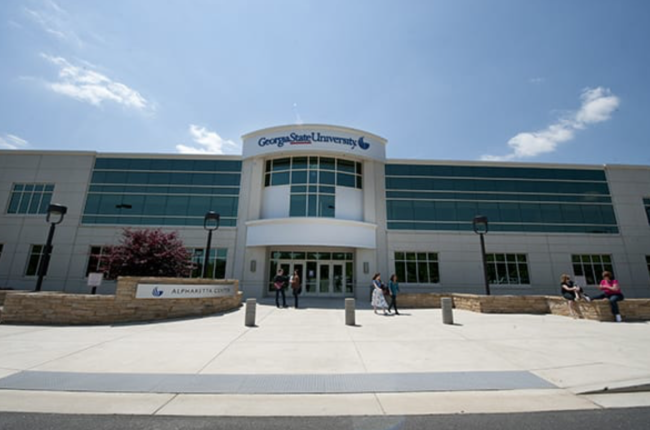You have /5 articles left.
Sign up for a free account or log in.

Georgia State University’s Perimeter College
Georgia State University
An associate professor of English at Georgia State University’s two-year Perimeter College is no longer teaching in person this term after she called campus police to her classroom to remove two students who arrived late and refused to leave.
The two students, who have only been publicly identified by their first names, are Black, as is the professor. Internally and in public statements, Georgia State has condemned the idea of calling campus police on students for being late to class.
Much of the public criticism of the professor, Carissa Gray, meanwhile, has centered on the fact that she called campus police on Black students, in particular, in this era of increased awareness of racial dynamics in policing.
Gray did not respond to an interview request and has not commented publicly on the case. She will continue teaching an asynchronous online class this term, but her in-person teaching duties will be assumed by someone else, according to information from the university. Georgia State plans on making counseling available this week to students in the class in question.
“The provost and police chief have reached out to meet with the affected students. The professor is no longer teaching in-person classes this semester,” Georgia State said in a statement Friday. “Campus police arrived after being called by the faculty member and de-escalated the situation between the students and faculty member. Clearly, no crime had been committed so there were no arrests.”
In an email to faculty members, Nicolle Parsons-Pollard, interim provost of Georgia State, said that the university’s student code of conduct prohibits disruptive behavior, but that “police should only be called if the disruptive behavior poses an immediate threat to the safety of the instructor, the student or any other students or persons.”
Parsons-Pollard further advised faculty members to review the university’s published guidance on disruption in the learning environment. That document tells instructors to inform the student or students in questions that they are being disruptive and ask them to stop. “If there is no immediate safety concern and the student ceases the disruption, the student may remain in that class session and the instructor submits an online ‘Student of Concern’ referral as soon as possible after the class session,” the guidance says.
If a student doesn’t cease the disruption, but there is no immediate safety concern and the incident “can be reasonably managed by the instructor,” the guidance continues, the student can stay in the class session (after which the professor should submit a referral).
When there is a safety concern, or when “the student’s level of continued disruption cannot be reasonably managed by the instructor, ask the student to leave the classroom,” Georgia State says. “If the student does not comply with the direction to leave the classroom, or if the student complies but the immediate concern for safety continues even after the student departs the classroom, contact the GSU Police.”
The student code of conduct defines disruption like this: “To interrupt, impede or obstruct teaching, instructional, research, disciplinary, public service, administration, or other university activities.”
The two students involved in the incident reported it to university officials last week, but it became international news after a third Georgia State student who said she witnessed what happened shared her story on TikTok.
Here’s what TikTok user @briaisok said in her video:
Two Black students had the police called on them today at Georgia State’s Perimeter campus in Newton County for being two minutes late to class. You heard me correctly, two minutes late to class and they had the police called on them. When the professor then asked them to leave, Taylor [one of the late students] responded and said, “We paid to be here.” The professor, Carissa Gray, then responded, “OK,” and left the room. When she returned, she returned with two armed police officers. The woman cop, whose name I do not know, proceeded to grab Taylor’s things and try to forcibly remove them from the room. They then said that if they did not leave, they would be charged with trespassing. The students arrived to the classroom, the door was wide-open, they were allowed to enter, walk all the way to their seats, sit down and proceed to take out their things to take notes.
The woman police officer proceeded to hold on to Taylor’s things until Taylor agreed to leave. She then went down to the advisement center to figure out who it was that she could talk to to file a report. She was directed to go to the [department chair, who] told Taylor that her only two options were to either stay in an environment that she didn’t feel safe in or take an F. We went across the street to the other building to file a complaint with the student life department. We were then informed that this was not the first time that the police had been called on a student for something irrational. Taylor also disclosed that she felt as though this action taken by Professor Carissa Gray was in retaliation to an earlier event that happened earlier on in the semester.
The TikTok user, @briaisok, elsewhere identified as Bria Blake, ended the video by saying, “Time and time again, we’ve seen the police being weaponized against Black people. Calling the police on to students for being two minutes late to class is extremely unreasonable and dangerous. Both of the students, a woman and a man, started crying because they were so terrified of what could happen to them. Please share this video. I’m trying to spread this story so that people can know what’s going on. Stuff like this cannot keep happening to Black youth in America. Stop weaponizing the police against Black people.”
This isn’t the first time a professor has been accused of weaponizing campus police against Black students, though most other high-profile incidents have involved a white professor. The University of Texas at San Antonio, for instance, investigated Anita Moss, a longtime lecturer of anatomy and physiology, in 2018, after she called campus police on a Black student who was resting her feet on a chair in class. The university determined that Moss, who is white, was not motivated by racial bias against the student, but that she overreacted when she called the police. Moss was ordered to complete classroom management training but was investigated soon after she returned to the classroom for warning students via her syllabi against “placing your legs or feet on the classroom furniture,” “reclining in class” and other “disrespectful behavior.” Moss, who was not tenured, was not renewed following the second incident.
Averting the Breakdown
The feet-on-the-chair case prompted UTSA to form a 21st Century Learning Environments Task Group, charged with considering “what is needed to create a learning environment that encourages critical thinking, communication, collaboration, and creativity, and acknowledges the social and cultural changes that have occurred from the 20th to 21st century and the readiness of faculty and students to negotiate adapting to these changes.”
The task force recommended a series of changes, including “reimagining the syllabus for Gen Z,” requiring a teaching philosophy statement, more professional development and “humanizing both faculty and students” by various means. Another recommendation on building “student ownership” encouraged creating classroom guidelines together as a class—faculty and students—at the start of a semester. This idea is already a popular in K-12 classrooms.
In 2020, UTSA said it was absorbing the recommendations of the task force into a larger Equity Advocacy Initiative, aimed at enhancing the “student experience in and out of the classroom with an intentional grounding in diversity, inclusion and equity.”
Kevin Gannon, director of the Center for Excellence in Teaching and Learning professor of history at Grand View University in Iowa, said that "unless there is the threat of direct harm, calling police into a classroom isn’t the answer, I don’t think."
Gannon also said that while there clearly are missing details about just what happened at Georgia State, he considered it evidence that many faculty members “don’t get the type of professional development and support they need in order to have the tools to handle these types of things constructively.” Beyond that, he added, “I see it as an indicator that we are still very much not OK” with respect to pandemic-era teaching.
COVID-19 “has disrupted every element of the teaching and learning process,” while institutional policies about health, masking and even teaching modality are often beyond faculty members’ control, Gannon said. And “rigid attendance and punctuality policies can often be an indicator of how little control or agency an instructor feels they have. And that gets taken out on students, unfortunately.”
Wendy Murawski, executive director and Eisner Endowed Chair at the Center for Teaching & Learning at California State University, Northridge, said that any expectations about tardiness and associated repercussions should be documented in advance in class syllabi, which act as “contracts” between students and faculty members.
Best practice is “typically to have a very short grace period, such as five minutes, where the faculty member might be doing a warm-up or introducing the agenda for the day,” Murawski said. “We all recognize that things happen, such as traffic and parking issues.” There is also a current push toward trauma-informed teaching, she continued, “as so many of us—faculty and students alike—are struggling due to a variety of factors, many of them related to the pandemic and its impact on us as individuals.” It’s therefore “very difficult for me to see a situation in which a student should be penalized that severely for being just a few minutes late to class, should that be the case. Now more than ever we should all be giving one another grace.”
When and if a student is disruptive by being late, Murawski said, there are “many” alternatives to summoning campus police, who “have far more serious issues to deal with than classroom management.”
“Faculty, even in higher education, should be equipped with strategies to manage their own classrooms,” she continued, suggesting what are known as positive behavior interventions and supports as one example: in this case a professor might “praise the other students for getting there on time and saying how helpful it is to the class to be able to continue, rather than calling out those students who are late.”
Another way to deal with late students would “simply be to ask those two students to see her after class to discuss how their continued tardiness impacts the flow of the class and to agree on behaviors going forward,” Murawski said. Another idea? Some professors count attendance points and write into their syllabi that points will be subtracted for lateness.
“While a faculty member may think that students’ tardiness detracts from their learning and the learning of others, certainly taking the time to go and get police detracts far more time and attention from the subject matter being taught,” Murawski said. “Ultimately though, most of this stems from a need to develop a relationship between professor and student. The more we know our students and what they are going through, and the more we communicate with them about our own needs in teaching the class, the better the outcome for everyone.”





